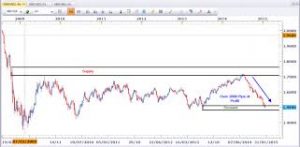
Unlike long-term trading strategies, active trading relies on short-term movements. Active traders need to quickly buy and sell securities in order to profit from the price changes.
Meanwhile, the long-term strategies require you to have a different kind of mentality. Most investors who use buy-and-hold strategies expect the price changes to have a more significant long-term meaning. In contrast, active traders believe that the only way you could profit is by using those short-term price changes.
There are many active trading strategies used every day on the stock market. Here are the four most popular ones.
Day Trading
Just like the name says, day trading requires you to buy and sell securities during the same day. People often use it as a synonym for active trading, and it is probably the most famous method.
When you are a day trader, you cannot keep your securities overnight – you have to close your position on the same day. In addition, day trading is not for beginners. Usually, there are professional day traders, like market makers and specialists. Still, because technology has advanced in recent years, novices can try to day trade too.
There are a lot of powerful tools that can be used to scan the stock market and find ideal trading setups. Trade Ideas offers powerful scanners backed by artificial intelligence. This Trade Ideas review ranked the platform as one of the best stock market scanners. Of course, a scanner is just one tool in your toolkit. You will still need to know how to use the tools if you want to be successful.
Position Trading
Many people actually think that this method is more of a buy and hold strategy. However, when you are an advanced trader, you can use it for active trading as well.
Position trading refers to determining the current market trend. A position trader will use long-term charts and combine them with other methods. The charts could be daily, weekly, or even monthly. That means that the trade could last anywhere from two days to several weeks. If the trend is exceptionally difficult to discover, it could last longer.
In order to define the trend, position traders are constantly looking for higher and lower highs. They can then use that trend to make a profit from the highest and the lowest market movements. However, that doesn’t mean they are trying to foresee the price levels.
They are usually looking for already successful trends. Furthermore, once the trend crumbles, they will often exit their position. That means that there aren’t many opportunities for them when the market is experiencing high volatility.
Swing Trading
Once a trend falls into pieces, that is when swing traders make an appearance. When it ends, the prices will frequently change to accommodate a new trend. Swing traders can then use that volatility to make a profit.
They usually hold their position overnight, but the trades are still short-term. In addition, these traders often use a set of rules. They use fundamental or technical analysis to determine the rules and identify their next investment. However, their algorithms don’t have to be on point every time – they just have to use them in a one-directional market. Other markets, such as range-bound and sideways, are just too risky for swing traders.
Scalping
If you want to earn a quick profit, then the scalping strategy might be the right one for you. During bid/ask spreads, and many order flows, price gaps are a frequent occurrence. Therefore, scalpers can use them to get a small profit.
This strategy can be quite risky, so they make sure they hold their positions for a short period of time. Furthermore, they avoid trading high volumes and making large moves. Instead, they focus on small, yet frequent market moves and small volumes.
Because profits per trade are usually small, they often try to find liquid markets which will enable them to earn more. Also, they try to stay away from volatile markets and prefer trading on the quiet ones. Thus, they can avoid abrupt price movements.
Is Active Trading Expensive?
You probably already know that active trading requires you to save up a lot of money. That is because it is vital to cover all your losses if they happen. Furthermore, you have to use a fantastic brokerage house, and make frequent trades.

You can lower the costs by having an in-house brokerage. In addition, such brokerage can also help you have a better execution rate. Thus, you will be making a significant profit while paying a low commission.
Active trading also requires you to buy high-quality software and hardware. That means that an individual trader might not have enough money to support an active trading career.
Final Words
When entering an active trading career, it is vital to think about your options carefully. You have to pick the right strategy, and you also have to make sure you can afford to implement it. Only then can you actually expect it to work for you and help you make a profit.
You also have to bear in mind that you can only pick one strategy. Combining them could lead to confusion, and it could also severely lower your gains.